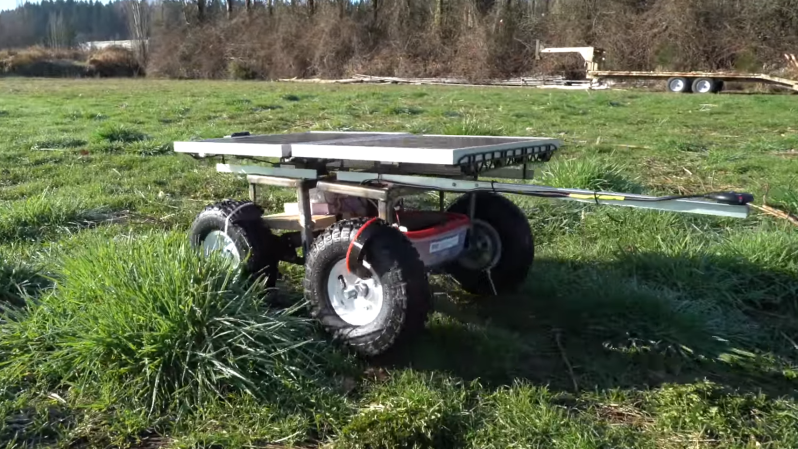The solar panel technology we have available today doesn’t really lend itself to practical everyday transport. But when speed isn’t a concern, it can make for some very interesting autonomous rovers. One example of this is [Daniel Riley] aka [rctestflight]’s solar powered rover, which he built to live autonomously at his flight testing field, crawling around whenever it has gathered enough juice from the sun.
[Daniel] has thing for autonomous craft of all types, with quite a few aircraft and boats to his name. This rover is built around a welded steel frame, with each wheel driven by a brushless geared motors via a chain. While it’s technically a skid steer, the electronic speed controls are from a quadcopter and can’t reverse, so it doesn’t turn quite on the spot.
With the rigid steel frame, any small bump in the ground would cause one wheel to lose traction. To fix this, the frame was cut in two and a pivot added in the center, allowing all four wheels to always remain on the ground. Another problem is that the wheels would sometimes dig themselves into the soft wet ground, so this, [Daniel] attached a 3D printed “hump” to each drive wheel, which helps them to climb out of any soft spots. For the next version of this rover, [Daniel] plans to use cheap DC geared motors from a Barbie jeep. They’re a bit too fast though, so he’ll be adding 3D printed cycloidal reduction gearboxes. We’re definitely looking forward to seeing here this project goes from here.
There have been a number of projects to test solar powered robots for agricultural use. We really like the idea, with its potential for long duration missions. Imagine something like this roaming the Black Rock playa in the US, the Makgadikgadi Pan in Botswana, or even the Sahara Desert, while gathering environmental data and making awesome time-lapse videos.















On private soil this may work… I’d like to have a rover driving around and exploring the environment… but we all remember what happens to bots in an area with horror sapiens infection… :-(
We will not forget you, Hitchbot!
Do I really need to steal a planet to have the space for driving around an own rover?
:-(
With an articulated chassis you’re off to a good start. It’s worth considering a rocker-bogie system even if the ground seems level to larger-scale humans, but that would argue for keeping the independent wheel drives.
https://en.wikipedia.org/wiki/Rocker-bogie
Rocker-bogie stuff is intended for very low speeds because this tends to transmit shock and other impulse loads to the the rest of the vehicle. Also, this type of suspension requires that the motor be built into the hub. I have settled on trailing-arm suspension for my rear drive wheels, with fully articulated front-wheel steering.
This design uses a direct-all drive model with no suspension elements for shock dampening – probably ok when you can keep speed very low and there are no harmonics that need to be dampened. For something that roves about in a fully autonomous manner, I would expect that chain drive is a reliability issue.
I have built a number of solar powered wheelchairs, since wheelchair is what I get at pocket price with motors, battery and joystick control, which can be easily replaced by RC.
Glass laminated solar panels are very heavy for such projects, so I use semi-flexible solar panels, which don’t crack under stress.
2 powered wheels by individual motors, should go first to never “dig themselves into the soft wet ground”
for this reason, front drive wheels should be oversized.
Battery-free solar drive approach is not smart, since you can easily loose your rover, driving to far in the evening, getting no enough solar energy to go back.
So battery is a must and GPS tracker is another must, if you let your solar rover to turn into autonomous mode.
Solar rover is not fit for any agriculatural use, for obvious reasons, since solar energy is limited to 1,000w/m2 of solar panel/s, converting solar energy into electric energy at 12-15% efficiency only.
Since solar panels not point directly to the sun ( no solar tracking), what you get installing 240W m2 size solar panel is
half of nominal power.
Lightweight electric bike requires 2 full-sized, semi-flexible solar panels for a continuous drive ( no battery mode).
In theory you can build such solar powered rover, but in practice I use light trailer to pack more semi-flexible solar panels to increase active surface to 4m2
You can email me if interested
hfexchange at gmail
Won’t work at Black Rock because A: BLM has become annoying, B: it is a lake right now.
what is attached to the tyres and what for ?
(vide images on top)
They’re bumps for extra traction.
Described in the writeup, and in the video, BTW.
Thank you.
Great idea to install such bumps in my car, one day , for extra traction ;)
Video is great
I am just buying another one electric wheelchair to get it converted into solar wheelchair (RC rover)
after few months of work.
Today I completed courses by WHO in Coronavirus Infection Prevention and Control to help us save Italy
A reel-type lawnmower attachment would be nice.
Having used reel mowers in the past, they feel like they need a minimum amount of momentum to the reel to work, and this doesn’t seem to move near fast enough.
This rocks so hard. I’ve been catching up over the past 6-months on all of your videos on youtube. Not sure but I suspect we must live pretty close together. I must drive past your fest field (guessing) between Bothell (just outside Mill-Creek on the east side) and Redmond (specifically, south of Woodinville?) on my way to work when I head into the office for work 3-4 times a year. Otherwise I work from home and on the weekends play in the robotics studio.